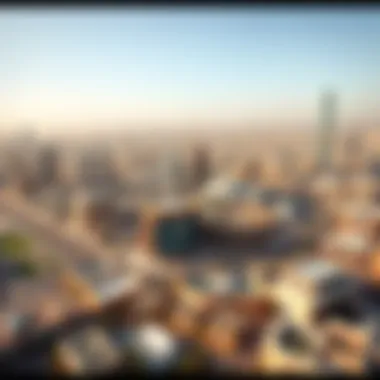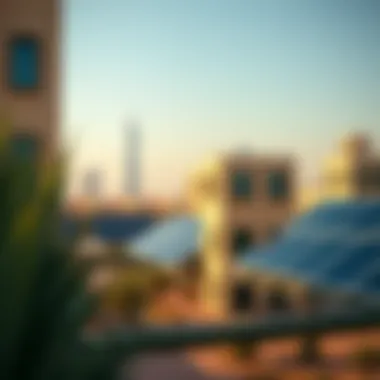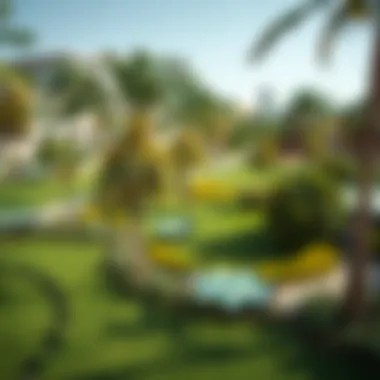Masdar City: Leading the Way in Sustainable Urban Design


Intro
In the heart of Abu Dhabi lies Masdar City, a hub of innovation and sustainability that redefines urban landscapes. This ambitious project is not just about bricks and mortar; it’s a response to the urgent need for smart urban solutions in an ever-evolving world. Masdar City challenges traditional notions of city planning, seamlessly integrating technology, renewable resources, and eco-friendly practices into its very fabric.
As investors and stakeholders look toward future developments within the real estate sector, understanding what makes Masdar City a standout feature in urban design is crucial. The city's conception dates back to 2006, aiming to create an ecosystem where clean technology and sustainable living coalesce. It's humbling to note that this project is more than a mere cluster of structures; it serves as a vibrant community, fusing residential and commercial spaces, all while aiming for a zero-carbon footprint.
This article delves into the intricacies of the Masdar City Project, shedding light on its strategic objectives, infrastructure, and socio-economic ramifications for Dubai and beyond. It captures green initiatives that set the standard in urban living.
Through examining its architectural design and the significant role renewable energy plays in its operation, we aim to uncover how Masdar City serves as a model for sustainable urbanization. Moreover, we will confront the challenges encountered, derive lessons learned, and consider the broader implications on real estate and urban development.
Let’s embark on this insightful journey.
Prelims to Masdar City
Understanding the Masdar City Project is crucial for anyone interested in innovative urban design and sustainable development. This project is not just a new city rising in the desert; it's a blueprint for the future of urban living, notably in arid regions. By focusing on sustainability, Masdar City provides insights into how we can develop urban spaces that harmonize with nature instead of harming it. The blend of technology with eco-friendly practices makes it a fascinating case study for investors, urban planners, and environmentalists alike.
Origins and Vision
The genesis of Masdar City can be traced back to 2006, when Abu Dhabi declared its commitment to sustainable development amidst its rapid economic growth fueled by oil. The vision for Masdar was crystal clear: to create the world’s first zero-carbon, zero-waste city. This ambitious undertaking not only aimed to showcase sustainable technologies but also envisioned a hub for clean-tech companies. The founders wanted a place where innovation would meet practice – an incubator for ideas that could change urban living everywhere.
The underlying philosophy here is that the future must be built on green principles, as traditional models are proving unsustainable. Masdar embodies this thought process, aspiring to redefine interactions between urban dwellers and their environments. Its origin reflects a fusion of cultural respect for tradition with forward-looking ideals of progress. The creators saw Masdar City not merely as bricks and mortar, but as a living experiment showcasing how technology and nature can coexist productively.
Goals and Objectives
The goals of Masdar City extend beyond merely being a carbon-neutral zone; they touch on various aspects, including:
- Sustainable Living: Promote a lifestyle that decreases reliance on fossil fuels and encourages the use of renewable energy.
- Economic Diversification: Create an economic ecosystem that incorporates clean technology, thereby aligning the city’s future with global shifts towards sustainability.
- Community Building: Foster a sense of community among residents by integrating green spaces and mixed-use areas that promote social interaction.
- Education and Research: Establish Masdar as a center for research and education in sustainable practices, encouraging knowledge transfer globally.
Through these objectives, Masdar City aspires to be a model of sustainable urbanization, addressing not only local challenges but also serving as a prototype for cities around the world. In a time where cities are growing at an unprecedented rate, the smart and sustainable practices being adopted in Masdar could pave the way for a broader understanding of what urban environments can become.
Location and Geography
The relationship between location and geography is a cornerstone in the development of sustainable cities, and Masdar City is no exception. The unique positioning of Masdar City, combined with its geographical attributes, plays a vital role in both its operational efficacy and its ambition to serve as a global benchmark for sustainable urban environments.
Strategic Positioning in Abu Dhabi
Masdar City is strategically nestled in Abu Dhabi, the capital of the United Arab Emirates. This location isn't just a matter of coincidence—it's a meticulously calculated decision aimed at harnessing the benefits of economic opportunity and a supportive governmental framework that emphasizes sustainability.
Being in Abu Dhabi allows Masdar City access to significant financial resources and policy support. The government here places a strong emphasis on moving toward a greener future, rallying efforts to diversify its economy away from oil dependency. Masdar City serves as a flagship project that showcases this shift.
By situating the city close to major transportation links and cultural hubs, planners have ensured that Masdar isn't just a remote outpost. Its proximity to international airports and urban centers facilitates both connectivity and collaboration with businesses, academics, and tourists. Moreover, this strategic location attracts investment from both local and international stakeholders who see value in sustainable innovation.
Climate Considerations
Climate is an ever-pressing consideration for urban development, particularly in an arid setting like Abu Dhabi. This geographical reality necessitated that Masdar City be designed with climate resilience firmly in mind. The region experiences extreme temperatures and low rainfall, prompting the need for extraordinary measures to ensure sustainability and livability.
Architectural innovations in Masdar City proactively address these climatic challenges. For instance, buildings within the city are oriented to take full advantage of prevailing winds, providing natural ventilation and minimizing the reliance on air conditioning. Additionally, the design incorporates thick walls and shading devices that dramatically reduce solar gain, which is crucial during the scorching summer months.
Water conservation is another critical aspect tied to climate considerations. Given the scarcity of freshwater resources, Masdar City employs advanced water management systems that include greywater recycling and rainwater harvesting. Thus ensuring that even under restrictive climatic conditions, residents can enjoy necessary resources without compromising sustainability.
In summary, the thoughtful consideration of location and climate in the planning of Masdar City not only enhance its sustainability credentials but also set a precedent for cities worldwide aiming to create habitable spaces that respect both their geographical and environmental context. The challenges posed by location and climate have become opportunities for innovation that may very well define the future of urban living.
Sustainable Infrastructure
The concept of sustainable infrastructure is crucial in redefining urban growth in today's world. In the context of Masdar City, sustainable infrastructure represents a holistic approach to urban design, where every element complements a shared goal of sustainability. This encompasses not only energy-efficient buildings and public spaces but also transportation systems that prioritize eco-friendliness, waste management strategies that minimize landfill use, and water conservation techniques that ensure the responsible use of resources. By weaving together these facets, Masdar City presents a model worth examining for investors, analysts, and expatriates keen on understanding the future of urban living.
Transportation Systems
Transportation within Masdar City exemplifies a radical shift from the traditional car-centric urban development model. The city was designed around pedestrian pathways and eco-friendly public transit options. For instance, the Personal Rapid Transit (PRT) system operates autonomously, providing residents and visitors easy access to various points within the city. Unlike conventional transport methods, this approach significantly reduces carbon emissions.
The planners were mindful to limit the use of conventional vehicles, opting instead for shared electric vehicles and bicycles, which encourages a healthier lifestyle among residents.
“The transportation system minimizes reliance on fossil fuels and promotes a cleaner, greener commute.”
Additionally, the integration of smart mobility solutions, such as app-driven services, contributes to efficient traffic management. This not only enhances the mobility experience but also reduces congestion, making transportation throughout the city seamless and less stressful.
Waste Management Solutions
Waste management at Masdar City is a showcase of innovation. Here, the focus lies on reducing, reusing, and recycling waste materials. The city integrates a source-separation system for waste, which allows for easy disposal and processing of materials, reducing the overall waste that goes to landfills. This mindful approach ensures that valuable resources find new life instead of being discarded.
Moreover, onsite composting facilities serve to convert organic waste into compost, which can be used to nourish plants throughout the city's landscaped areas. Aiming for a minimum of two-thirds of waste to be recycled or composted, Masdar City sets an ambitious standard, pushing the envelope in sustainable urban living.
Water Conservation Techniques
Water management in dry regions can be a daunting task, yet Masdar City employs several innovative water conservation techniques to address this issue effectively. The use of reclaimed water for irrigation is a prime example; instead of relying solely on freshwater resources, treated wastewater is utilized to maintain green spaces and landscaping. Additionally, the architectural layouts within the city include features that collect and retain rainwater, which is then directed to underground cisterns for later use.
These strategies not only enhance the overall sustainability of the city's infrastructure but also foster a culture of awareness regarding water usage among residents.
By redirecting focus on sustainable infrastructure, Masdar City stands as an exemplary case study, demonstrating how intentional design can influence environmental stewardship and community wellbeing. This aim intertwines with broader aspirations for sustainable urban growth, paving the way for future developments that prioritize ecological integrity alongside urban advancement.
Architectural Design Elements
Architectural design elements play a pivotal role in the Masdar City project, significantly influencing its identity, functionality, and sustainability. The careful selection of design components not only enhances the aesthetic appeal but also aligns with the core principles of sustainability and environmental stewardship. By focusing on such elements, the project demonstrates how modern design can harmonize with nature while catering to urban needs.


Innovative Building Techniques
Masdar City employs innovative building techniques that challenge traditional construction paradigms. The emphasis on modular construction, for instance, allows for faster assembly while reducing waste. This method permits the use of localized resources, which diminishes the carbon footprint associated with long-distance transport. Notably, many structures are built from recycled materials, further reflecting the commitment to sustainability.
In addition to modular techniques, the design incorporates passive solar design principles. Buildings are oriented to maximize natural light, reducing the need for artificial lighting. This not only cuts energy consumption but also fosters a brighter, more inviting interior environment. Insulation materials are chosen not only for their energy-saving properties but their sustainability, too.
Key techniques in Masdar City include:
- Green roofs: These not only provide insulation but also enhance biodiversity within the urban landscape.
- Ventilation stacks: Designed to facilitate air flow, they create a natural breeze that cools buildings without relying heavily on air conditioning.
The combination of these techniques illustrates how design can directly impact energy efficiency. Thus, the architectural strategies in Masdar City not only reflect an innovative approach to building, they also contribute substantively to the overall sustainability goals of the project.
Integration of Nature in Urbanism
The integration of nature within Masdar City’s architectural framework is a defining characteristic that enriches urban life while adhering to ecological principles. This is not merely an afterthought but a fundamental design philosophy that aims to reconnect urban dwellers with nature.
One striking example is the extensive use of landscaped open areas that facilitate biodiversity. Native plants are chosen to ensure water conservation, providing a habitat for local fauna. These green spaces serve multiple functions; they help in cooling the urban heat by reducing surrounding temperatures while providing residents with spaces to relax and socialize.
Moreover, the use of biophilic design elements—features that support human affinity to nature—further enhances the city’s livability. This includes natural water features and extensive greenery that can be found throughout the urban landscape. These elements are more than just aesthetic; they also contribute to mental well-being, as studies have shown that access to nature can reduce stress and promote a sense of community.
In summary, the architectural elements of Masdar City are meticulously curated to echo the overarching vision of sustainability and livability. With innovative building techniques and a deep-seated commitment to integrating nature within urban spaces, the project exemplifies how future urban development can be shaped by thoughtfulness and foresight.
Renewable Energy Initiatives
Renewable energy initiatives are at the core of Masdar City’s role as a beacon of sustainability in urban development. The city is designed not only to reduce its carbon footprint but also to serve as a model for how other urban areas can integrate renewable energy resources. By pivoting towards solar and wind power, Masdar City aligns itself with global sustainability goals while showcasing a practical application of these technologies.
The benefits of investing in renewable energy are myriad. Firstly, it decreases reliance on fossil fuels, which are finite and contribute significantly to environmental degradation. Second, the initiatives create job opportunities in emerging sectors, promoting economic growth. Lastly, engaging with renewable energy fosters a community ethos centered around stewardship of the environment, which helps shape resident and investor perceptions of responsibility and sustainability.
Solar Energy Utilization
Solar energy utilization stands at the forefront of Masdar City’s renewable energy framework. Positioned in a region that enjoys abundant sunshine, the strategic exploitation of solar power has enabled the city to fulfill a significant portion of its energy needs. The rooftops of buildings, open spaces, and even parking lots are adorned with solar panels, soaking up sunlight and converting it into electricity. More than just a pretty sight, this system buffers the strain on traditional power grids.
Masdar’s first major solar project, the Shams 1 concentrated solar power plant, marked a pivotal development in harnessing this energy source. It generates enough energy to power roughly 20,000 homes and serves as a demonstration of what’s possible when sunlight is leveraged effectively.
Furthermore, the city promotes the adoption of solar technologies among residents and businesses alike, incentivizing them by providing educational resources and support. This reciprocity not only enhances energy efficiency but also fosters a culture of innovation around renewable practices.
Wind Energy Contributions
In addition to solar, wind energy contributions are another vital component of Masdar City's energy strategy. Although the desert landscape may not appear ideal for wind farms, Masdar has recognized the potential of wind as an alternative energy source. The city’s planners have integrated small-scale wind turbines into the urban design, harnessing natural airflow to generate electricity.
Wind turbines, strategically placed around Masdar, operate quietly and efficiently. They contribute to the overall energy mix while showcasing how urban landscapes can work harmoniously with natural elements. This integration serves a dual purpose: it not only provides energy but also educates citizens and visitors about the potential of this renewable resource. The collective impact of these turbines is significant, enhancing the city’s energy resilience and contributing to a more balanced energy portfolio.
"Masdar City's dedication to renewable energy is a commitment to a sustainable future—one that could inspire cities around the world to rethink their energy strategies."
By emphasizing both solar and wind energy, Masdar City serves as a case study of how cutting-edge renewable energy systems can be integrated into urban settings. The commitment to these initiatives is not only about energy production; it is a clarion call for broader environmental awareness, making a well-rounded argument for sustainability in the urban paradigm.
Economic Impacts
Focusing on the economic ramifications of Masdar City provides a clear lens through which to assess not just its successes, but also its potential pitfalls. At a time when sustainable urban development becomes paramount, understanding how Masdar City influences the economy enriches the narrative around this unconventional project. Built on the ethos of sustainability, the economic effects extend beyond just the initial investment—it encompasses long-term growth, innovation, and employment.
Attracting Investment
In the realm of urban development, attracting investment is crucial. Masdar City serves as a magnet for both local and international investors. As an initiative backed by the government of Abu Dhabi, it has managed to combine prestige with purpose. The commitment from key players—like the Abu Dhabi Future Energy Company—signals a robust investment landscape. Investors are increasingly drawn to projects that prioritize sustainability.
Masdar presents a unique proposition. It offers not only a chance to contribute to one of the world's most ambitious eco-cities but also potential returns on investment through its focus on renewable energy and advanced technology sectors.
- Renewable Energy Initiatives: Strengthening the economic argument, the city’s focus on solar and wind energy attracts energy investors interested in subsequent projects.
- Business Environment Support: The infrastructure designed to support clean technology companies further enhances investor confidence.
- Global Reputation: The international profile associated with Masdar City boosts investor interest, as the project signifies forward-thinking and modernization in the region.
Masdar’s allure as an investment destination cannot be understated.
Job Creation and Workforce Development
Tied closely to investment is the aspect of job creation, which acts as a lifeline for any burgeoning city. Masdar City is not merely an architectural marvel or eco-friendly initiative; it’s also a generator of employment opportunities that align with global sustainability trends.
The city fosters diverse opportunities across various sectors:
- Green Jobs: From architects specializing in eco-design to engineers focused on renewable technologies, the creation of green job roles grows steadily. These jobs are essential, not only to the city’s ecosystem but also to the wider market.
- Training and Education Initiatives: Masdar’s collaboration with universities and research institutions fosters a skilled workforce equipped for future challenges. The Masdar Institute of Science and Technology exemplifies this effort, bolstering educational standards.
- Local Communities Engagement: Integrating local communities means that many job opportunities arise for residents, promoting economic inclusivity within Masdar City.
Quote: "A city that creates job opportunities for its residents is a city that nurtures its future."
The impact of job creation in Masdar City extends beyond numbers; it represents a shift in job quality and local community investment, attracting a workforce ready to engage with challenges in innovative ways.
For more detailed insights and continual updates on these developments, see Wikipedia and Britannica for comprehensive overviews.
Community Engagement and Lifestyle
Community engagement and lifestyle form the heartbeat of Masdar City. The way residents interact with their environment can significantly enhance sustainability goals, nurture social connections, and foster a climate of innovation.
Creating a vibrant community involves more than just building energy-efficient homes or installing solar panels. It necessitates a holistic approach that prioritizes human interaction and well-being. In Masdar City, the design fosters collaboration. Streets are pedestrian-friendly, which encourages walking and cynosure community spirit while minimizing reliance on cars. This thoughtful layout has profound implications: not only does it reduce carbon emissions, but it also promotes a healthier, more active population.
Living and Working in Masdar City


Residents in Masdar City enjoy a unique blend of living and working environments. The mixed-use developments provide easy access to offices, shops, and recreational spaces, allowing for a seamless balance between personal and professional lives.
The emphasis on smart technology enhances daily life. For instance, smart meters track energy use, helping individuals and businesses optimize their consumption. It’s like having a personal energy manager nudging you to save.
Moreover, community forums and workshops enable local residents to contribute to decision-making processes. This participatory approach helps to ensure that the community reflects the diverse needs and preferences of its inhabitants. By engaging people in this way, Masdar City cultivates a sense of ownership and pride among its residents. This type of empowerment is crucial for any urban development aiming to be sustainable.
Cultural and Recreational Amenities
Cultural and recreational amenities play a vital role in making Masdar City not just a place to live, but a place to thrive. Art installations, parks, and communal spaces breathe life into the city, providing areas for socializing, relaxation, and community activities.
- Art and Culture: Masdar City celebrates local culture through art displays and community events that highlight Emirati heritage. These events are great opportunities for community bonding and learning.
- Parks and Open Spaces: Green areas are interspersed throughout the city, offering residents a respite from the hustle and bustle. They serve as venues for sports, gatherings, and family activities, reinforcing the notion that nature and urban life can coalesce harmoniously.
- Wellness Initiatives: Programs promoting mental and physical health, such as yoga in the park or community runs, resonate well with the lifestyle of Masdar residents. The city’s design encourages these kinds of activities, making health a community affair rather than an individual responsibility.
In summary, the lifestyle in Masdar City is designed to be interconnected, promoting a strong sense of community and encouraging sustainable living practices among residents. The emphasis on engagement and cultural vitality is not just advantageous; it embodies the very principles that Masdar City champions in its quest for a sustainable future.
Challenges Encountered
Addressing urban development within a sustainable framework presents a multitude of challenges, especially for ambitious projects like Masdar City. Recognizing these obstacles is crucial for investors, planners, and policy makers. The journey to establishing a pioneering city is riddled with financial, technical, and logistical difficulties, each requiring strategic foresight and adaptive problem-solving to navigate effectively. By thoroughly examining these challenges, stakeholders can better understand the complexities involved in sustainable urbanization.
Financial Viability Concerns
One of the primary concerns for the Masdar City Project is ensuring its financial viability – something that lingers in the minds of investors and government officials alike. Developing a city from scratch isn't just about innovative ideas; it requires a sound financial backing as well. Here are key aspects related to financial viability:
- Investment Strategies: Creating a comprehensive funding model is essential for maintaining momentum. Without strong initial investments, long-term goals can quickly hit the skids. Masdar City had ambitious plans, but funding must attract ongoing investments to realize its objectives fully.
- Return on Investment (ROI): Investors naturally want to see returns. The challenge here lies in balancing sustainability goals with financial outcomes. It's commonly recognized that eco-friendly initiatives can sometimes come with higher upfront costs, and securing confidence from investors is no small feat.
- Economic Incentives: Government support through subsidies, grants, or incentives may play a vital role in stabilizing financial concerns. Tailoring these incentives to attract both local and international investment could be critical in realizing the city’s vision.
In the face of these financial hurdles, a holistic approach targeting profitability while championing sustainable innovation is paramount.
Technical and Logistical Hurdles
Equally significant are the technical and logistical challenges faced during the development of Masdar City. These issues can impact the timeline of the project and its overall feasibility. Here’s a closer look at these hurdles:
- Infrastructure Development: One of the dreams of Masdar City is to create an integrated, efficient infrastructure that champions sustainability. However, designing and constructing such infrastructure poses numerous challenges, including ensuring compatibility with existing systems, implementing cutting-edge technology, and maintaining functionality within a harmony of natural and urban elements.
- Supply Chain Management: Sourcing sustainable materials presents logistical challenges. Identifying suppliers who adhere to ecological standards can complicate procurement processes and timelines while also potentially inflating costs.
- Implementation of Technologies: There’s no denying that deploying new technologies seamlessly is a complex endeavor. Implementing smart solutions like energy-efficient systems and renewable resources necessitates skilled labor, which can sometimes be in short supply. Moreover, aligning everyone involved—from contractors to subcontractors—under a single vision requires a well-orchestrated effort.
These technical obstacles underscore the reality that innovation must often adapt to the constraints of practicality, showcasing the need for persistence and flexibility in urban planning.
“Challenges are what make life interesting, overcoming them is what makes life meaningful.” - Joshua J. Marine
Understanding and addressing these hurdles not only paves the way for successful sustainable developments but also lays the groundwork for future endeavors in urban planning. By embracing these lessons, both Masdar City and similar projects can steer toward a more sustainable, financially viable future.
Lessons Learned from Masdar City
The Masdar City Project is not just a modern marvel of architecture; it's a blueprint for future urban developments aiming for sustainability. This section delves into the insights gained from Masdar City's execution, shedding light on vital learnings that can be applied to urban planning globally. The significance of such reflections lies in their potential to influence policies, strategies, and technologies that drive sustainable urbanization, making them relevant to investors, agents, buyers, analysts, and expatriates alike.
Insights into Urban Planning
One of the primary lessons from Masdar City is the critical role of comprehensive urban planning. This city has highlighted that a holistic approach is necessary, considering not only technological innovations but also cultural, social, and economic factors. For instance, the planners of Masdar City adopted a unique layout, one which encourages walking over driving. This integrated approach of fostering walkable environments has resulted in lower emissions and promoted healthier lifestyles.
Key insights include:
- Community-centric designs: Successful urban spaces must prioritize human scale and comfort, enhancing livability.
- Adaptive reuse: By repurposing existing infrastructures and incorporating local materials with modern technology, planners can maintain cultural echo.
- Long-term vision: It’s essential to envision future implications and adaptive strategies as climate conditions evolve over decades.
"Designing for people, and not just for buildings, is paramount. The city is a living ecosystem that needs to be responsive and dynamic."
Role of Technology in Sustainable Development
Masdar City stands tall as a testament to how technology can revolutionize sustainable development. From energy-efficient buildings to intelligent transport systems, the integration of advanced technologies is not just an add-on; it's the backbone of Masdar.
Several technologies have garnered attention:
- Smart grid solutions: This technology ensures efficient energy distribution, adapting in real time to the demands of the community, thus reducing waste.
- Building Information Modeling (BIM): Embraced during the planning stages, BIM technology has enabled precise construction management and minimized errors.
- IoT applications: Using sensors to monitor environmental factors has allowed for real-time data collection, aiding in better resource management.
These applications illustrate how embedding technology into the fabric of urban planning can not only optimize resource use but also enhance the quality of life for residents.
The lessons from Masdar City are invaluable. They pave the way for informed decision-making and initiatives that prioritize sustainability and innovation in the face of rapid global urbanization. By assessing these insights, stakeholders can navigate the complex challenges that come with building future-ready cities.
Future Prospects of Masdar City
The future of Masdar City holds immense promise not only for the urban landscape of Abu Dhabi but also serves as a beacon for cities worldwide looking to adopt sustainable practices. As urban centers grapple with rising populations and environmental concerns, the vision for Masdar City embodies an innovative and sustainable approach. Its potential goes beyond just being a residential area; it aims to become a global model for sustainable living.
Expansion Plans and Vision
With an ever-expanding vision, the plans for Masdar City include the development of new residential zones and commercial spaces designed to accommodate future generations. These expansion efforts play a crucial role in meeting the challenges of urbanization while maintaining a commitment to sustainability.
- Innovative Urban Planning: The expansion involves incorporating smart technologies, like IoT solutions, to optimize everything from energy use to traffic flow within the city. Such planning is not just about building; it's about creating an adaptive ecosystem that can evolve with changing needs.
- Sustainability at its Core: Future designs will prioritize energy efficiency and minimize ecological footprints. This means ongoing enhancements to solar power generation capabilities and innovative water reuse systems.
- Economic Growth Opportunities: Expanded areas will offer new commercial prospects. By attracting startups and established businesses in the renewable energy sectors, these developments can transform Masdar City into a hub of innovation.
- Community Integration: Efforts to foster community engagement remain at the forefront of the expansion plans. Creating spaces that blend residential and commercial areas allows for a vibrant community life and facilitates social interactions.
Masdar City's journey is not without its challenges, but the continued push toward an integrated and sustainable future underscores its importance. As urban planners and investors take cues from Masdar's model, there's a significant wave of inspiration gaining momentum around the globe. The city aims to elevate the standards of urban living, thus shaping how future developments are conceived and executed.
"Success in creating a sustainable urban environment relies heavily on innovation and community involvement. Masdar City sets a precedent for what is possible when those elements are combined."
Comparative Analysis with Other Sustainable Cities
A comparative analysis of Masdar City with other sustainable cities gives an understanding of its unique place in the global landscape of urban development. Such analyses are pivotal because they allow stakeholders — from investors to city planners — to gauge the effectiveness of various sustainability strategies. Additionally, examining other cities can highlight best practices and inform future improvements in Masdar City itself.


Global Leaders in Sustainability
Cities like Copenhagen, Stockholm, and Singapore are often heralded as global icons of sustainability. Each has embarked on diverse paths toward reducing their carbon footprint and enhancing livability. For instance, Copenhagen is renowned for its cycling infrastructure, targeting to become carbon-neutral by 2025. Similarly, Singapore has integrated its natural landscape with urban living, implementing extensive green roof systems and water management initiatives.
- Copenhagen:
- Stockholm:
- Singapore:
- Cycling Infrastructure: 62% of citizens commute by bike daily.
- Renewable Energy: Aiming for wind energy dominance in the future.
- Waste Management: Over 99% of waste is recycled or reused.
- Energy Production: Employs a district heating system powered by renewable sources.
- Green Spaces: More than 50% of the city is greenery.
- Innovative Water Solutions: Uses reclaimed water for irrigation and drinking.
Each of these cities has implemented policies that not only promote sustainability but also enhance the quality of life for residents. These leaders do not just focus on one aspect — they consider transportation, energy, waste, and community engagement in tandem.
Lessons from International Examples
Studying cities that lead the charge in sustainable practices reveals several key lessons that can benefit Masdar City and inform its ongoing development:
- Integrated Urban Planning: Developing an inclusive strategy that harmonizes natural landscapes with urban design can foster biodiversity and improve urban livability.
- Community Involvement: Having residents involved in planning leads to environments that better fit their needs. Engaging citizens creates a sense of ownership that encourages sustainable practices at an individual level.
- Flexibility and Adaptability: Cities must remain agile in adopting new technologies and practices. What works today might not be as effective tomorrow, particularly in the rapidly evolving landscape of urban development.
- Partnerships: Collaboration between public agencies and private entities is essential for pooling resources and expertise. Public-private partnerships often catalyze innovation and accelerate project completion.
By drawing from the achievements and shortcomings of these cities, Masdar can further hone its approach toward sustainable urban living. As it navigates the complexities of urbanization in the 21st century, the lessons gleaned from a wider lens will be invaluable to reinforcing its role as a pioneer in sustainability.
"Sustainability isn’t just a goal; it's a journey that needs constant learning and adjustment."
Regulatory Framework and Governance
The fabric of Masdar City's ambitious sustainability vision is woven with a stringent regulatory framework and robust governance practices. These elements are vital, not merely as a guiding light for development, but as a foundational pillar that ensures all activities align with the overarching goal of promoting environmental integrity and social equity. Here, we delve into the specific aspects of planning and regulatory policies, along with the significance of public-private partnerships, effectively framing Masdar City as a model for sustainable urban development.
Planning and Regulatory Policies
The planning and regulatory policies surrounding Masdar City serve as more than just bureaucratic red tape. They are designed to provide a comprehensive strategy for development that harmonizes sustainability objectives with urban growth. The Abu Dhabi Urban Planning Council, for instance, has instituted guidelines to ensure that all construction projects comply with environmental standards and resource efficiency principles.
- Zoning Regulations: These regulations define land uses within Masdar, aiming to minimize pollution and maximize green spaces. For instance, residential areas are strategically designed to be mixed with commercial spaces, reducing vehicular dependency.
- Building Codes: The city mandates energy-efficient building practices. Developers must adhere to rigorous energy performance standards, which can result in lower operational costs and minimized environmental impact over time.
- Sustainability Certification: All projects must achieve a minimum green building certification, such as LEED or Estidama. This ensures that building practices are genuinely sustainable, contributing to the quality of life for residents.
With such a meticulous approach to regulation, Masdar City is not only a physical space but a fully realized vision of sustainable urbanism.
Public-Private Partnerships
Public-private partnerships (PPPs) have been instrumental in advancing the Masdar City project. These collaborations leverage the strengths of both public entities and private investors to foster innovation, increase funding sources, and distribute risks. The model has several noteworthy advantages:
- Shared Expertise: By merging public oversight with private sector agility, the project benefits from diverse expertise that is crucial for overcoming complex sustainability challenges.
- Financial Synergies: Private investment fuels development without fully relying on public funding, allowing projects to move forward robustly and swiftly. For example, companies like Masdar, a subsidiary of the Abu Dhabi government, facilitate investments in renewable energy and green technologies.
- Enhanced Deliverables: Engaging private entities can lead to advanced solutions in technology and infrastructure, often surpassing the capabilities of public sector developments alone.
The interplay between stringent regulations and strategic partnerships embodies the essence of how Masdar City not only aspires to be a leader in sustainability but also serves as a benchmark for other cities aiming for similar goals.
For more on the regulatory framework that shapes sustainable cities, you can visit the Abu Dhabi Urban Planning Council.
As investors, agents, and analysts delve into the ambitions of Masdar City, understanding this regulatory and governance landscape helps inform critical strategies for engagement and investment.
Impact on Dubai’s Real Estate Market
The Masdar City Project represents a significant paradigm shift in how urban development is approached, especially in regions like Dubai, where the desert landscape has traditionally dictated living conditions and real estate dynamics. Understanding the impact of Masdar City on Dubai's real estate market provides insights into both the challenges and opportunities emerging from this unique initiative. This section examines two critical aspects: property trends and investor perceptions.
Influencing Property Trends
Masdar City's innovative approach to sustainability is reshaping property trends not just within its own boundaries but across the greater Dubai area. Properties within Masdar are often marketed with a strong emphasis on energy efficiency, sophisticated design, and integration of technology. The focus on green living appeals to a growing demographic that prioritizes sustainability, thereby gradually influencing how developments are conceptualized elsewhere in Dubai.
- Green Certifications: With a push for sustainable development, properties in Masdar City have obtained various green certifications, ensuring they meet rigorous environmental standards. This has sparked a new norm in real estate where buyers are more aware and often demand eco-friendly features in new properties.
- Trendy Living Spaces: The architectural design, which melds modernity with nature, offers a fresh take on urban living. Developers outside Masdar are now looking to incorporate similar design principles, aiming to appeal to the eco-conscious buyer. Consequently, the demand for contemporary eco-friendly communities is likely to rise, as prospective homeowners are drawn towards properties that not only promise comfort but also align with their values regarding environmental responsibility.
Additionally, the rise in transportation accessibility due to efficient public transport in Masdar City is influencing property values across Dubai. Buyers are increasingly considering proximity to sustainable transit options, understanding that such access can enhance day-to-day living and positively impact property appreciation over time.
Shaping Investor Perceptions
The perception of investors regarding real estate opportunities in Dubai is evolving due to the Masdar City initiative. What was once a market focused primarily on luxury and high-rise developments is now expanding to embrace projects that emphasize sustainability. Investors are beginning to see green investments as not only responsible but also profitable in the long run.
- Increased Demand for Sustainable Investments: The successes of Masdar City have stirred interest from domestic and international investors who see the potential for returns in eco-friendly developments. Properties in areas that adopt similar philosophies are attracting attention, leading to a clear trend: sustainable projects are becoming a high-priority investment sector.
- Long-term Value: Investors are also starting to understand that properties developed with sustainability in mind are likely to maintain or even appreciate in value as regulatory pressures on carbon emissions increase. As more cities adopt similar initiatives, Masdar City's pioneering steps could serve as a template that informs future investments.
"Sustainability in urban development isn't just a trend; it's rapidly becoming a necessity driven by consumer demand and regulatory requirements."
Ultimately, the influence of Masdar City on Dubai’s real estate market underscores a crucial evolution in urban development. By paving the way for innovative, sustainable practices, it has not merely set a benchmark for future projects. It has reshaped the foundational expectations of investors and buyers alike, redefining what it means to live and invest in a city purpose-built for the future.
For more insights into urban sustainability and real estate trends, visit Britannica's coverage of sustainable cities.
Ending
In the grand scheme of urban development, the Masdar City Project stands as a hallmark of innovation and sustainability. This initiative not only underscores the significance of merging technology with ecological responsibility but also provides a roadmap for future cities worldwide. By focusing on various elements, such as energy efficiency, community engagement, and innovative architectural designs, Masdar City serves as a capable imitation model for future urban projects, showing that a greener, smarter way of living is indeed feasible.
Summarizing Key Insights
Reflecting on the insights gathered throughout this article, here are some key points worth mentioning:
- Holistic Sustainability: Masdar City embodies a holistic approach to sustainability, integrating renewable energy sources, efficient waste management, and water conservation techniques under one roof. This is not just about technology but also about cultivating a lifestyle that prioritizes environmental well-being.
- Community-Centric Design: The planning in Masdar City is tailored for its community, encouraging a lifestyle that fosters interaction among residents. Rather than designing for the individual or the vehicle, the layout promotes walkability and accessibility.
- Adaptive Energy Solutions: The reliance on solar and wind energy is not merely an afterthought in Masdar’s blueprint; it’s a core ethos that drives nearly every operational aspect, offering a resilient framework that can adapt to changing energy demands.
- Economic Viability: The project illustrates that sustainability can indeed coexist with economic interests. By attracting investments and generating employment, Masdar City is showing how green initiatives can lead to tangible economic benefits alongside responsible resource management.
- Learning Experience: The challenges encountered during the project’s progression provide valuable lessons for future urban developments, such as the importance of consistent funding and the necessity of addressing technological hurdles systematically.
Looking Ahead
As we gaze towards the future, the lessons learned from Masdar City could set a precedent for upcoming urban spaces around the globe. Key areas to focus on include:
- Scaling Up Successful Models: Future projects should examine the frameworks established by Masdar City, adapting and scaling them according to local contexts and needs. This adaptability is key, as one-size-fits-all approaches rarely succeed in the varied landscapes of urban environments.
- Continued Innovation: As climate concerns grow, the need for innovative solutions remains paramount. Investing in research and development can lead to breakthroughs that enhance the sustainable functionalities of urban designs.
- Stronger Regulatory Frameworks: For projects akin to Masdar City to thrive, there need to be robust regulations and supportive governance frameworks that promote sustainability without stifling creativity or investment.
- Global Collaboration: Finally, fostering international cooperation among cities involved in sustainable practices can lead to knowledge sharing and collective problem-solving. In a world increasingly affected by climate change, collaboration might just be the linchpin for success.
Masdar City is not an endpoint; it’s a stepping stone toward a more sustainable urban future that other cities across the globe can aspire to emulate. The possibilities are indeed as vast as the desert sky.



